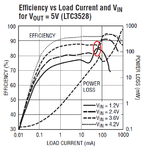Safiya
Junior Member level 2
Hi, Everyone,
I have designed simple boost converter, with
Vi=1.8v
vo=5v
Io= 60mA
ΔIL = 167mA (1.37A to 1.544 A)
Isw= 1.4A (0 to 1.4A spikes)
L=1u
fs= 1M
Could some one please guide me to rough estimate of Efficiency ?
does the ΔIL variation from 1.3A to 1.5A is normal or it must be reduced ?
-Thanks
Safiya
I have designed simple boost converter, with
Vi=1.8v
vo=5v
Io= 60mA
ΔIL = 167mA (1.37A to 1.544 A)
Isw= 1.4A (0 to 1.4A spikes)
L=1u
fs= 1M
Could some one please guide me to rough estimate of Efficiency ?
does the ΔIL variation from 1.3A to 1.5A is normal or it must be reduced ?
-Thanks
Safiya
